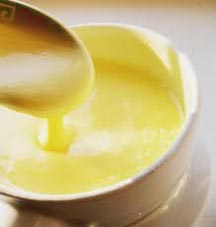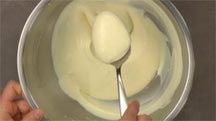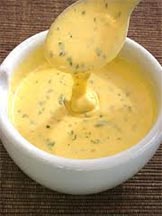3 Delicious Tricks with Hollandaise Sauce
By Alice Osborne
 This classic French emulsion sauce has a bad reputation: it's supposed to be tricky to make and easy to ruin. But like mayonnaise, it's not as temperamental as you might think. And if you make hollandaise in a blender of food processor, it's practically foolproof.
This classic French emulsion sauce has a bad reputation: it's supposed to be tricky to make and easy to ruin. But like mayonnaise, it's not as temperamental as you might think. And if you make hollandaise in a blender of food processor, it's practically foolproof.
Blender or processor hollandaise is a very thick, smooth sauce. Cooked hollandaise, on the other hand, is a fluffier, more delicate sauce. With either method, one whole egg or three egg yolks can be used interchangeably. The all-yolk sauce simply has a more golden color and tends to be thicker.
 Rich and elegant, this sauce makes the most of freshly cooked artichokes or asparagus; it's also a wonderful choice to crown poached fish or Eggs Benedict. And once you've mastered the simple art of making hollandaise sauce, there are 3 delicious tricks you'll have up your sleeve that will take your cooking to a whole new level.
Rich and elegant, this sauce makes the most of freshly cooked artichokes or asparagus; it's also a wonderful choice to crown poached fish or Eggs Benedict. And once you've mastered the simple art of making hollandaise sauce, there are 3 delicious tricks you'll have up your sleeve that will take your cooking to a whole new level.
First...
Basic Hollandaise Sauce
Yield: 1 to 1 1/2 cups 1 whole egg or 3 egg yolks
1 whole egg or 3 egg yolks
1 tsp Dijon or other prepared mustard
1 Tbsp lemon juice or white wine vinegar
1 cup (1/2 lb) butter, melted and hot
Blender or food processor: Whirl egg, mustard, and lemon juice until well blended. With motor on high, add butter, a few drops at a time in the beginning, but increasing to a slow, steady stream as mixture begins to thicken. Serve immediately. Or, if sauce is to be used within several hours, pour into a jar, cover, and let stand; then warm the sauce by bringing it to room temperature and stirring to soften. Place jar in water that's hot to touch; stir until sauce is warm but not hot. If made further ahead, cover and refrigerate for up to a week; bring to room temperature before warming.
Cooked hollandaise: Using a wire whisk or portable electric mixer, combine, egg, mustard, and lemon juice in the top of a double boiler. Place pan over gently simmering water (water should not boil or touch bottom of pan). Beating constantly, add butter, a few drops at a time in the beginning, but increasing to a slow, steady stream as mixture begins to thicken. After all butter is added, continue to cook, beating, until sauce thickens. A cooked whole-egg sauce should look like cream that is just beginning to thicken when whipped; an all-yolk sauce should be thick enough to hold its shape briefly when dropped from a beater.
As soon as sauce has thickened, remove from heat and serve immediately. Or, see instructions above for reheating.
 Now for the 3 tricks that will add a crown of glory to your steamed vegetables or fish:
Now for the 3 tricks that will add a crown of glory to your steamed vegetables or fish:
Mousseline Sauce: Prepare basic hollandaise sauce. Whip 1/2 cup whipping cream until stiff peaks form; fold into hollandaise sauce (hot or at room temperature). Serve immediately over boiled or steamed vegetables or fish.
 Bearnaise Sauce: In a small saucepan, combine 1 Tbsp minced shallot or onion, 1 tsp dry tarragon, and 3 Tbsp white wine vinegar. Simmer over medium heat until liquid is reduced to 2 tsp. Prepare hollandaise sauce, but stir shallot mixture (hot or cold) into egg, mustard, and lemon juice before adding butter. Good with green beans, salmon, beef, broiled chicken, lamb, and egg dishes.
Bearnaise Sauce: In a small saucepan, combine 1 Tbsp minced shallot or onion, 1 tsp dry tarragon, and 3 Tbsp white wine vinegar. Simmer over medium heat until liquid is reduced to 2 tsp. Prepare hollandaise sauce, but stir shallot mixture (hot or cold) into egg, mustard, and lemon juice before adding butter. Good with green beans, salmon, beef, broiled chicken, lamb, and egg dishes.
 Maltaise Sauce: Prepare hollandaise sauce, but stir 2 Tbsp orange juice and 1/2 tsp grated orange peel into egg mixture before adding butter. Good with asparagus (shown on white asparagus), broccoli, and Brussels sprouts.
Maltaise Sauce: Prepare hollandaise sauce, but stir 2 Tbsp orange juice and 1/2 tsp grated orange peel into egg mixture before adding butter. Good with asparagus (shown on white asparagus), broccoli, and Brussels sprouts.


